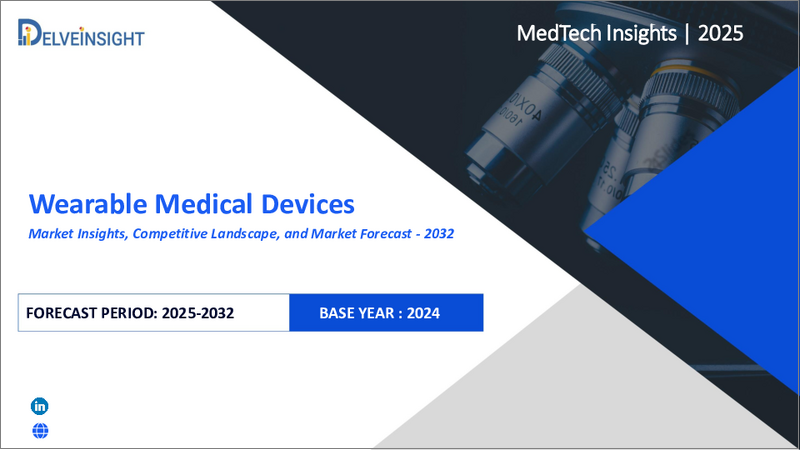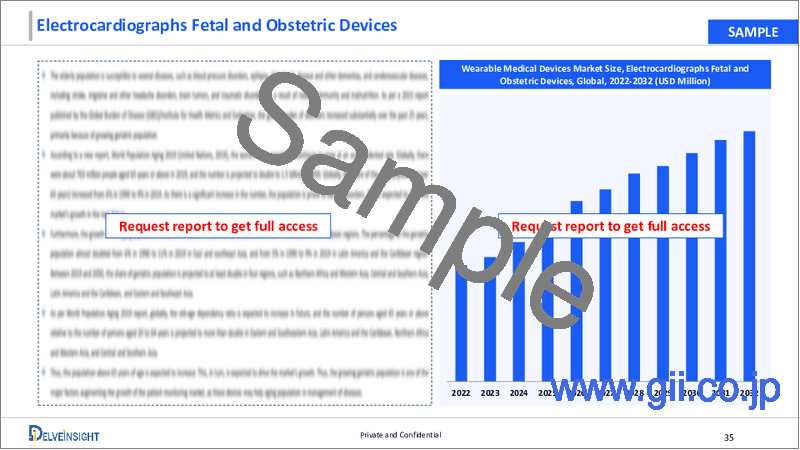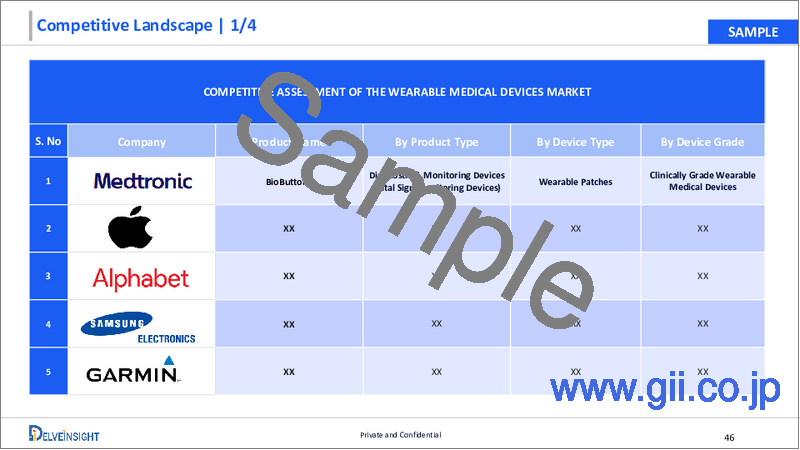|
|
市場調査レポート
商品コード
1863131
ウェアラブル医療機器の世界市場:洞察、競合情勢、市場予測:2032年Wearable Medical Devices - Market Insights, Competitive Landscape, and Market Forecast - 2032 |
||||||
カスタマイズ可能
適宜更新あり
|
|||||||
| ウェアラブル医療機器の世界市場:洞察、競合情勢、市場予測:2032年 |
|
出版日: 2025年11月01日
発行: DelveInsight
ページ情報: 英文 150 Pages
納期: 2~10営業日
|
概要
ウェアラブル医療機器市場のサマリー
- 世界のウェアラブル医療機器市場は、力強く持続的な成長を反映して、2024年の429億8,129万米ドルから2032年には1,854億1,573万米ドルに増加すると予測されます。
- 世界のウェアラブル医療機器市場は、2025年から2032年までの予測期間中にCAGR 20.07%で成長しています。
- 世界のウェアラブル医療機器市場は、慢性疾患有病率の上昇、遠隔患者モニタリングへのシフト、急速な技術進歩に後押しされて急成長しています。小型化されたセンサー、AI主導の洞察、5Gコネクティビティにより、ウェアラブルはフィットネスガジェットから、プロアクティブでコネクテッドなヘルスケアに不可欠な医療ツールへと進化しつつあります。
- ウェアラブル医療機器市場で事業を展開する主要企業には、Apple Inc.、Alphabet Inc.、Samsung Electronics Co., Ltd.、Garmin Ltd.、Koninklijke Philips N.V.、Medtronic, Abbott Laboratories、Dexcom, Inc.、Boston Scientific Corporation、OMRON Corporation、ResMed、Becton、Dickinson and Company、iRhythm Technologies, Inc.、Withings、Vital Connect, Inc.、Masimo Corporation、Insulet Corporation、Zoll Medical Corporation、Biotricity Inc.、Nuvo Group, Ypsomedなどがあります。
- 北米は、高度な医療インフラ、一人当たり医療費の高さ、強力なイノベーション・エコシステム別支えられており、ウェアラブル医療機器市場において支配的な地位を維持すると予想されます。また、病院における臨床グレードの機器と、医療用としてFDAの認可を取得しつつあるコンシューマーグレードのウェアラブルの両方が採用されていることも成長を後押ししています。
- ウェアラブル医療機器市場の製品タイプ別では、診断・モニタリング機器カテゴリーが2024年に最大の市場シェアを占めると推定されます。
ウェアラブル医療機器市場の成長要因
- ウェアラブル医療機器市場の急拡大につながる慢性疾患の増加と高齢化:糖尿病、心血管疾患、呼吸器疾患などの慢性疾患の罹患率の上昇は、市場の主要な促進要因です。これらの疾患は、継続的なモニタリングと長期的な管理を必要とします。ウェアラブル医療機器は、心拍数、血圧、血糖値などのバイタルサインのデータを常時提供することで解決策を提供し、これを可能にします。
- 合併症の早期発見
- 個別化された疾病管理
- 患者の転帰の改善と医療費の削減
- 遠隔患者モニタリングと在宅医療へのシフト:医療システムは、従来の診療所でのケアモデルから、より便利で費用対効果の高い遠隔診療へと移行しつつあります。このシフトは、COVID-19パンデミックのような出来事別著しく加速しています。ウェアラブル端末はこの動向の中心にあり、これを可能にします。
- 遠隔患者モニタリング(RPM):医療提供者は離れた場所から患者の健康データをモニターすることができ、タイムリーな介入を可能にし、頻繁な通院や再入院の必要性を減らすことができます。
- 遠隔医療と遠隔治療:ウェアラブルからのデータを遠隔医療プラットフォームにシームレスに統合することができ、仮想診察中に患者の健康状態をより包括的に把握することができます。
- 利便性とアクセシビリティの向上:特に地方の患者や移動が困難な患者は、診療所まで足を運ぶというロジスティクスの課題なしに、質の高いケアを受けることができます。
- 技術の進歩:ハードウェアとソフトウェアの絶え間ない技術革新により、ウェアラブル医療機器はより正確で信頼性が高く、使いやすいものとなっています。主な技術進歩は以下の通りです。
- センサーの小型化:センサーの小型化と高機能化が進み、心拍(ECG)から血中酸素飽和度(SpO2)まで、より幅広い生理学的データを測定できる、より目立たず快適なデバイスの開発が可能になっています。
- AIと機械学習の統合:人工知能(AI)アルゴリズムは、ウェアラブルが収集した膨大な量のデータを分析し、実用的な洞察、予測分析、パーソナライズされた健康推奨を提供します。
- 接続性の強化:Bluetoothのような無線技術の向上と5Gの展開により、デバイスからスマートフォンやクラウドベースの健康プラットフォームへのシームレスでリアルタイムのデータ転送が可能になります。
- バッテリー寿命の向上:バッテリーの長寿命化により、連続モニタリングがより実用的になり、頻繁な充電の必要性が減少しています。
ウェアラブル医療機器市場レポート区分
このウェアラブル医療機器市場レポートは、世界のウェアラブル医療機器市場の包括的な概要を提供し、主要動向、成長促進要因、課題、機会を明らかにします。製品タイプ別、デバイスタイプ別、デバイスグレード別、用途別、流通チャネル別、および地域別の主要市場における競合環境、規制状況、市場力学に関する貴重な考察を提供しています。業界をリードする企業の詳細なプロファイルや最近の製品動向を掲載することで、市場の可能性を見極め、戦略的計画を策定し、急成長するウェアラブル医療機器市場の新たな機会を活用するために不可欠なデータを企業に提供します。
ウェアラブル医療機器とは、身体に装着したり取り付けたりして、ユーザーの健康状態やフィットネスデータを継続的に追跡・収集する電子機器の一種です。
世界のウェアラブル医療機器市場は、慢性疾患の負担増、遠隔患者モニタリングや在宅ケアの採用拡大、画期的な技術革新などを背景に、急速に拡大しています。主な実現要因としては、バイタルサインの連続的かつ慎重な追跡を可能にするセンサーの小型化、予測分析と個別化分析のためのAIの統合、シームレスなリアルタイムデータ伝送を可能にする高速5Gネットワークの展開などが挙げられます。これらの力が相まって、ウェアラブルは単なるフィットネス・アクセサリーから、予防的、プロアクティブ、コネクテッド・ヘルスケアの中核となる不可欠な医療ツールへと変貌を遂げつつあります。
世界のウェアラブル医療機器市場は、小型化されたMEMSセンサー、AI/MLアナリティクス、ユビキタス・ブロードバンドが融合し、ケアをエピソード型から継続型へと移行させることで加速しています。この成長は基本的に技術的進歩に根ざしています。MEMS(微小電気機械システム)によるセンサーの小型化は、持続的なグルコースレベルから高解像度の心電図測定まで、より広範なバイタルサインを測定できる控えめで快適なデバイスの作成を可能にしています。このハードウェアの進化は、人工知能(AI)と機械学習(ML)の台頭によって補完されています。AIは心房細動のような状態の初期徴候を特定したり、低血糖イベントを予測したりすることができ、それによって医療をリアクティブからプロアクティブにシフトさせることができます。高速ワイヤレス・ネットワーク、特に5Gの普及は、遠隔患者モニタリング(RPM)のためのデータのリアルタイム伝送を容易にする重要なイネーブラーです。システム・レベルでは、5Gと最新のモバイル・ブロードバンドにより、継続的な遠隔患者モニタリング(RPM)が大規模に実用化されます。GSMAの報告によると、2025年までに世界のモバイル接続の約3分の1が5Gになり、リアルタイムの健康データ・フローの帯域幅と遅延が改善されます。
米国だけでも、カバー範囲が拡大し、臨床医が慢性期治療の経路にデジタル・モニタリングを組み込むことで、RPMを利用する患者数は2025年末までに7,100万人以上(人口の約26%)に達すると予測されています。DelveInisghtの分析によれば、RPMは病院の再入院を75%も減らすことができます。ハイテクセンサー、インテリジェント分析、ユビキタス接続のこの融合は、ウェアラブル機器の精度と実用性を高めるだけでなく、現代の分散型ヘルスケアの礎石でもあり、より個別化され、効率的で利用しやすい患者ケアの未来を約束するものです。
慢性疾患はかつてないレベルに達しています。2024年現在、推定5億8,900万人の成人が糖尿病を患っており、その数は2050年までに8億5,300万人に急増すると予測されています。また、5,300万~5,900万人が心房細動に罹患しており、心血管系のリスクは増加の一途をたどっています。さらに、睡眠の健康が重要な焦点として浮上しており、閉塞性睡眠時無呼吸症候群に罹患している成人は9億3,600万人に上り、その多くが診断を受けていません。これらの驚異的な数字は、ウェアラブルがもはやオプションではなく、予防的、個別化された、プロアクティブなヘルスケアの要になりつつある理由を浮き彫りにしています。
ウェアラブル医療機器市場は、飛躍的な成長を遂げる一方で、長期的な可能性を阻害しかねない多くの重大な市場抑制要因と課題に直面しています。第一の懸念は、データ・セキュリティとプライバシーに関するものです。ウェアラブル医療機器は、非常にセンシティブな個人健康情報を収集するため、サイバー攻撃の格好の標的となっています。データ・ガバナンスに関する明確で統一された規制の枠組みがないことは、データの取り扱いに関する消費者の不信感と相まって、普及の大きな障壁となっています。
さらに、多くの先進的な臨床グレードの機器が高コストで利用しやすい環境が限られていることと、保険業者による包括的な償還方針がないことが相まって、世界の人口の大部分には手が届かず、健康格差を悪化させています。
リアルタイム・モニタリングの絶え間ない要求は、現在のバッテリー寿命や電力管理の制限と衝突し、しばしばユーザーのコンプライアンス違反につながります。最後に、国によって異なる承認プロセスやデータの相互運用性の欠如など、規制や標準化のハードルがメーカーの市場参入を遅らせ、ウェアラブル・データの既存の医療システムへのシームレスな統合を妨げています。
ウェアラブル医療機器市場セグメント分析ウェアラブル
診断・モニタリング機器カテゴリーは、2024年の世界のウェアラブル医療機器市場シェアの60%以上を占め、主流採用が大きな原動力となっています。Apple、Samsung、フィットビットなどの大手企業が提供するスマートウォッチやフィットネスバンドは、心拍数トラッキング、歩数カウント、心電図モニタリング、睡眠分析などの機能を消費者の標準機能としています。
現在のシェアは小さいですが、治療用ウェアラブル分野は2025年~2032年の予測期間中にCAGR~23%の堅調な成長が予測されており、市場進化の高付加価値段階への移行を示唆しています。診断用ウェアラブルとは異なり、これらのデバイスは治療や疾病管理に積極的な役割を果たし、現代のヘルスケア提供における重要なツールとして位置づけられています。
ウェアラブル医療機器市場では、スマートウォッチ部門が市場を席巻しており、2024年の世界売上高の約45%を占めています。このリーダーシップは、大衆向け家電であると同時に、ますます信頼性が高まっている医療機器でもあるという二重のアイデンティティを反映しています。Apple、Samsung、Fitbitなどの業界リーダーに支えられ、スマートウォッチとリストバンドは、親しみやすく社会的に受け入れられるフォームファクターと強力なブランド・エコシステムを活用して、比類ない消費者浸透を達成しています。その魅力はヘルスケアにとどまらず、コミュニケーション、モバイル・ペイメント、エンターテインメントといったライフスタイルの機能を網羅し、日常生活に欠かせないものとなっています。
フィットネストラッカーと規制医療機器との境界は急速に侵食されつつあります。フィットネストラッカーと規制対象の医療機器との境界は急速に崩れてきています。現在、主要なスマートウォッチには、心房細動検出用の心電図(ECG)や連続SpO2モニタリングなど、臨床的に検証されたツールが組み込まれており、ウェルネスと遠隔患者モニタリング(RPM)の両方のための多用途プラットフォームへと変貌を遂げています。複数のバイタルサイン測定を1つのデバイスに統合する機能は利便性と臨床的価値を高め、予防医療モデルにとって非常に魅力的です。
消費者グレードのウェアラブル機器が世界のウェアラブル医療機器市場の大半のシェアを占めており、今後数年間で70%を超えると予測されています。スマートウォッチ(Apple、Samsung、Huawei)やフィットネストラッカー(Fitbit、Xiaomi)が大量に採用され、アクセシビリティ、手頃な価格、多機能の魅力を兼ね備えていることがその優位性に拍車をかけています。臨床グレードの機器とは異なり、これらの製品はオンラインマーケットプレースから家電小売チェーンまで多様な流通チャネルを通じて販売され、専門的なヘルスケアツールというよりはむしろライフスタイルの必需品として販売されています。積極的なブランディングとエコシステムの統合に裏打ちされたこの偏在性により、コンシューマーグレードのウェアラブル端末は、あらゆる層で家庭の主流アイテムとなっています。
コンシューマーグレード端末の魅力は、特定の病状よりもむしろ、健康とウェルネスに幅広く焦点を当てた点にあります。歩数、カロリー、心拍数、睡眠の質、ストレスレベルなどを追跡し、健康志向の高まる人々のニーズに応えます。このように一般化され、予防的な健康に焦点を当てることで、明確な慢性疾患や急性疾患の患者に対応する臨床グレードのウェアラブルと比較して、はるかに幅広いターゲット層を確保することができます。
オンライン流通チャネルは、2024年時点でもオフラインチャネルが総売上の50%以上を占めているもの、予測期間中の収益成長率とCAGRの両面で世界のウェアラブル医療機器市場を独占すると予測されます。
薬局、病院、専門クリニック、小売店などを含むオフラインチャネルは、特に持続血糖モニターや心臓モニタリング機器などの治療用および臨床認定用ウェアラブル機器にとって引き続き重要です。これらの製品は、医師の指導や処方、対面でのカウンセリングが必要な場合が多く、オフラインでの販売が不可欠となっています。
2024年、米国が世界のウェアラブル医療機器市場の43%を占めています。成長の原動力となっているのは、病院における臨床グレードの機器と、医療用としてFDAの認可を取得しつつあるコンシューマーグレードのウェアラブル機器の両方の採用であり、コンシューマーヘルスと臨床ケアの境界線が曖昧になっています。米国は依然として技術革新の中心地であり、遠隔監視ソリューションの償還主導型採用が進んでいます。
欧州ウェアラブル医療機器市場の動向
欧州のウェアラブル医療機器市場は、成熟経済と在宅医療ソリューションの採用拡大が混在することで形成され、力強い成長ハブとして浮上しています。この地域の高齢化、慢性疾患負担の増加、ドイツのDiGAフレームワークやEUのEHDS(European Health Data Space)プロジェクトなどの政府支援のデジタルヘルスイニシアチブが成長を支えています。ドイツ、英国、フランスのような成熟市場は、臨床グレードと消費者向けウェアラブルの両方の採用を推進しているが、南欧・東欧諸国は、医療のデジタル化の進展に支えられて追い上げています。しかし、同市場は、GDPR後の断片的なデータ共有政策、多様な償還の枠組み、複数の国の医療制度を利用することの複雑さなど、構造的なハードルに直面しています。企業にとっての成功は、国ごとに市場参入戦略を調整し、現地でパートナーシップを築き、EUの厳しい医療機器規制(MDR)を確実に遵守することにかかっていることが多いです。
アジア太平洋地域のウェアラブル医療機器市場は、膨大な人口基盤、中間層の医療支出の増加、糖尿病と高血圧の負担が世界一であることが背景にあり、世界全体で24.7%という驚異的なCAGRで成長すると予測されています。中国、インド、日本、韓国の各国政府は、デジタルヘルスエコシステムに積極的に投資し、遠隔医療インフラを拡大し、ウェアラブルの現地製造にインセンティブを与えています。スマートフォンの急速な普及と手頃な価格のデータプランがmHealthの統合をさらに可能にし、地域の新興企業やハイテク大手はAI主導の診断やコネクテッド・ヘルス・プラットフォームで積極的な革新を行っています。その結果、APACは単なる成長エンジンではなく、手頃な価格でスケーラブルかつ技術主導のヘルスケア提供の未来を形作る潜在的なトレンドセッターとなっています。
ウェアラブル医療機器市場の主要企業は以下の通りです。これらの企業は合計で最大の市場シェアを持ち、業界の動向を左右しています。
- Apple Inc.
- Alphabet Inc.
- Samsung Electronics Co., Ltd.
- Garmin Ltd.
- Koninklijke Philips N.V.
- Medtronic
- Abbott Laboratories
- Dexcom, Inc.
- Boston Scientific Corporation
- OMRON Corporation
- ResMed
- Becton, Dickinson and Company
- iRhythm Technologies, Inc.
- Withings
- Vital Connect, Inc.
- Masimo Corporation
- Insulet Corporation
- Zoll Medical Corporation
- Biotricity Inc.
- Nuvo Group
- Ypsomed
- その他
世界のウェアラブル医療機器市場は、上位が部分的に統合され、下位が断片化されたハイブリッド構造であると表現するのが最も適切です。ウェアラブル医療機器市場の競合情勢はダイナミックで、消費者向けハイテク大手、伝統的な医療機器企業、革新的な新興企業が混在しているのが特徴です。市場の上位への集中度は高く、Apple、Samsung、アルファベット(Fitbitを通じて)を含む一握りの支配的な企業が、ブランド認知度と広大なエコシステムを活用して、特にコンシューマーグレードのセグメントで大きな市場シェアを確保しています。
しかし、多数の中小企業や新興企業が、持続的なグルコースモニタリング(Dexcom、Abbott)や心臓モニタリング(Medtronic、iRhythm Technologies)など、特定の症状に特化した臨床グレードのデバイスに注力しており、市場は依然として断片化しています。市場を形成する主な競合戦略は、技術革新、戦略的パートナーシップ、規制当局の承認重視の融合です。消費者向けハイテク企業は、ウェルネスと臨床アプリケーションのギャップを埋めるため、スマートウォッチに医療認定機能(心電図、不整脈通知など)を急速に追加しています。
一方、従来の医療機器企業は、在宅医療や遠隔患者モニタリング分野で競争するため、製品を小型化し、ワイヤレス接続を統合しています。この熾烈な競争は、製品サイクルの迅速化を促し、より正確でユーザーフレンドリーな、臨床的に検証されたデバイスへの継続的なプッシュを促しています。
ウェアラブル医療機器市場における最近の開発動向
- 2025年5月、Masimo CorporationはMasimo W1ウォッチのFDA 510(k)認可を取得しました。この承認により、心拍数と酸素飽和度(SpO2)の連続測定とスポットチェック測定に適応が拡大され、さまざまな臨床現場で有効な選択肢となっています。
- 2025年4月、WHOOP, Inc.はWHOOP ECG機能のFDA認可を取得しました。この認可は、単一リードの心電図を提供し、特定の心拍不整脈を検出して通知する機能を検証するものです。この承認は、消費者グレードのデバイスがより医療に特化した領域に移行するための重要な一歩となります。
- 2025年4月、バイタルコネクト社はバイタルリズム・バイオセンサーのFDA 510(k)認可を取得しました。この認可は、心電図、心拍数、呼吸数を継続的に監視・記録する同デバイスの能力を検証するものであり、遠隔患者監視の有用性を高めるものです。
ウェアラブル医療機器市場のセグメンテーション
- ウェアラブル医療機器製品タイプ別動向
- 診断・モニタリング機器
- バイタルサイン・モニタリング機器
- 睡眠モニタリング機器
- 神経モニタリング機器
- 心電計胎児・産科用機器
- その他
- 治療機器
- 疼痛管理装置
- インスリン送達装置
- 呼吸療法機器
- リハビリテーション機器
- その他
- ウェアラブル医療機器デバイスタイプ別エクスポージャー
- スマートウォッチ
- リストバンド
- スマートウェア
- ウェアラブルパッチ
- その他
- ウェアラブル医療機器デバイスグレードの露出
- 消費者向けウェアラブル医療機器
- 臨床グレードのウェアラブル医療機器
- ウェアラブル医療機器の用途
- 一般的な健康とフィットネス
- 遠隔患者モニタリング
- ホームヘルスケア
- ウェアラブル医療機器の流通経路
- オフライン
- オンライン
- ウェアラブル医療機器販売地域
- 北米
- 米国
- カナダ
- メキシコ
- 欧州
- 英国
- ドイツ
- フランス
- イタリア
- スペイン
- その他欧州
- アジア太平洋
- 中国
- 日本
- インド
- オーストラリア
- 韓国
- その他アジア太平洋地域
- 世界のその他の地域
- 南米
- 中東
- アフリカ
インパクト分析AIを活用した
イノベーションとアプリケーション:
ウェアラブル医療機器市場へのAIの統合は、未加工の生体データを実用的な洞察に変換することで、ヘルスケアを根本的に再構築する変革の力となっています。AIを搭載したウェアラブルは、単純なデータ収集から、診断や予測能力の強化を可能にする高度な分析へと移行しており、心房細動のような状態の早期発見や糖尿病患者の低血糖イベントの予測を可能にしています。さらに、AIはユーザー固有の健康状態を分析し、食事や運動に関するカスタマイズされた推奨事項を提供することで、パーソナライズされた実用的な洞察を提供し、デバイスを効果的にパーソナル・ヘルス・アシスタントに変えます。医療提供者にとっては、AIが膨大な量のデータをフィルタリングして最も関連性の高い情報のみを提示することで、臨床ワークフローを合理化し、遠隔患者モニタリング(RPM)を可能にします。最後に、AIはデータの精度を向上させ、センサーの測定値からノイズをフィルタリングし、全体的なユーザー体験を向上させることによって、中核的な技術的課題にも対処し、ウェアラブル医療機器エコシステムの頭脳としての役割を確固たるものにしています。つまり、AIはウェアラブル医療機器市場の「頭脳」なのです。AIはウェアラブルを単なるデータロガーから、健康をモニターするだけでなく、ケアを予測、予防、パーソナライズするインテリジェントな健康パートナーへと変貌させ、最終的には患者と臨床医の双方に力を与えます。
ウェアラブル医療機器市場への米国関税の影響分析
輸入品に対する米国の新たな関税は、世界のウェアラブル医療機器市場にとって重大かつ複雑な逆風です。中国のような国から調達する必須部品のコストを引き上げることで、最大54%の関税は直接的に生産費を増加させています。このためメーカーは、コストを吸収して利益率を低下させるか、消費者に転嫁して市場の成長を鈍化させるかのいずれかを迫られています。これに対応するため、企業は戦略的にサプライチェーンを再評価し、より有利な貿易協定を結んでいる地域へと多様化し、さらには米国への生産の「リショアリング」を検討しています。関税の影響はすべてのセグメントに及び、コンシューマーグレードの健康トラッカーと重要な臨床グレードのデバイスの両方のコストを上昇させ、最終的には、患者にとってこれらの重要な技術の入手しやすさと手頃な価格を危険にさらす可能性のある不安定で不確実な市場環境を作り出します。
よくあるご質問
目次
第1章 ウェアラブル医療機器市場レポートの概要
第2章 ウェアラブル医療機器市場のエグゼクティブサマリー
第3章 ウェアラブル医療機器市場の主な要因分析
- ウェアラブル医療機器市場の促進要因
- 慢性疾患の増加と人口の高齢化
- 遠隔患者モニタリングと在宅ヘルスケアへの移行
- 健康意識と消費者の採用の増加
- 技術の進歩
- 高速接続とエッジコンピューティング
- ウェアラブル医療機器市場の抑制要因と課題
- サイバーセキュリティとデータプライバシーに関する懸念
- センサーの精度と信頼性
- データの相互運用性と標準化
- 技術およびユーザビリティの問題
- ウェアラブル医療機器の市場機会
- 人工知能(AI)と機械学習(ML)の統合とパーソナライズされたヘルスケア
第4章 影響分析
- AIを活用したイノベーションとアプリケーション
- 米国関税の影響分析
第5章 規制分析
- 米国
- 欧州
- 日本
- 中国
第6章 ウェアラブル医療機器市場:ポーターのファイブフォース分析
第7章 ウェアラブル医療機器市場の評価
- 製品タイプ別
- デバイスタイプ別
- デバイスグレード別
- 用途別
- 流通チャネル別
- 地域別
第8章 競合情勢
第9章 スタートアップの資金調達と投資動向
第10章 ウェアラブル医療機器市場の企業と製品プロファイル
- Apple
- Alphabet Inc.
- Samsung Electronics Co., Ltd.
- Garmin Ltd.
- Koninklijke Philips N.V.
- Medtronic
- Abbott Laboratories
- Dexcom, Inc.
- Boston Scientific Corporation
- OMRON Corporation
- ResMed
- Becton, Dickinson and Company
- iRhythm Technologies, Inc.
- Withings
- Vital Connect, Inc.
- Masimo Corporation
- Insulet Corporation
- Zoll Medical Corporation
- Biotricity Inc.
- Nuvo Group
- Ypsomed





